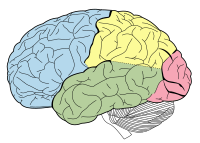
Photo from wikipedia
Background and Objectives Temporal lobe epilepsy (TLE) is the most common adult form of epilepsy and is associated with a high risk of cognitive deficits and depressed mood. However, little… Click to show full abstract
Background and Objectives Temporal lobe epilepsy (TLE) is the most common adult form of epilepsy and is associated with a high risk of cognitive deficits and depressed mood. However, little is known about the role of environmental factors on cognition and mood in TLE. This cross-sectional study examined the relationship between neighborhood deprivation and neuropsychological function in adults with TLE. Methods Neuropsychological data were obtained from a clinical registry of patients with TLE and included measures of intelligence, attention, processing speed, language, executive function, visuospatial skills, verbal/visual memory, depression, and anxiety. Home addresses were used to calculate the Area Deprivation Index (ADI) for each individual, which were separated into quintiles (i.e., quintile 1 = least disadvantaged and quintile 5 = most disadvantaged). Kruskal-Wallis tests compared quintile groups on cognitive domain scores and mood and anxiety scores. Multivariable regression models, with and without ADI, were estimated for overall cognitive phenotype and for mood and anxiety scores. Results A total of 800 patients (median age 38 years; 58% female) met all inclusion criteria. Effects of disadvantage (increasing ADI) were observed across nearly all measured cognitive domains and with significant increases in symptoms of depression and anxiety. Furthermore, patients in more disadvantaged ADI quintiles had increased odds of a worse cognitive phenotype (p = 0.013). Patients who self-identified as members of minoritized groups were overrepresented in the most disadvantaged ADI quintiles and were 2.91 (95% CI 1.87–4.54) times more likely to be in a severe cognitive phenotype than non-Hispanic White individuals (p < 0.001). However, accounting for ADI attenuated this relationship, suggesting neighborhood deprivation may account for some of the relationship between race/ethnicity and cognitive phenotype (ADI-adjusted proportional odds ratio 1.82, 95% CI 1.37–2.42). Discussion These findings highlight the importance of environmental factors and regional characteristics in neuropsychological studies of epilepsy. There are many potential mechanisms by which neighborhood disadvantage can adversely affect cognition (e.g., fewer educational opportunities, limited access to health care, food insecurity/poor nutrition, and greater medical comorbidities). Future research will seek to investigate these potential mechanisms and determine whether structural and functional alterations in the brain moderate the relationship between ADI and cognition.
Journal Title: Neurology
Year Published: 2023
Link to full text (if available)
Share on Social Media: Sign Up to like & get
recommendations!